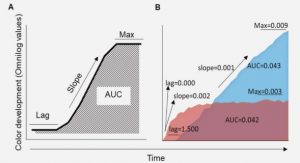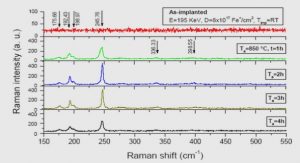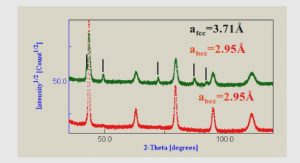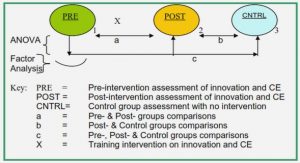Get Complete Project Material File(s) Now! »
Research Method
This chapter provides an overview of the research approach we used for this study. It presents motivations for the chosen methods and describes the processes of analysis and the applied research instruments in more detail. Furthermore, a discussion regarding research validity, in terms of confirmability, credibility, dependability and transferability is provided. In healthcare, ethical issues are highly important, these are presented in-depth.
Research Design
A research design is the plan for the entire research, it provides a road map of the whole project. Research design heavily influences the choice of philosophy and techniques. In our case, a qualitative research project. It includes a clear guideline and procedures with regard to what we intended to do, and why and how.
In Chapter 1: Research Problem, we have written the research proposal. That is, what we are we are going to do. In Chapter 2: Theoretical Framework, we developed our research questions. That is, what we intend to answer in this thesis. This chapter involves the decisions made about the various components of the undertaking of our research project: our philosophical assumptions, our research method, which data collection techniques we used, our approach to analyse the qualitative data and our writing up approach. Figure 5 presents the model of our qualitative research project.
We will briefly give an explanation of each step of the research design and the approach choices we made in each step for our project. Further on in this chapter we give an in-depth explanation.
Philosophical Assumption: Every research project is based on some philosophical assumptions about the nature of the world and how knowledge about the world can be obtained (Meyers, 2008, p. 35). These assumptions provide the foundation of everything that we did in this project.
Research technique: As researchers, we had to decide how we are going to investigate the social world. How we answered our research questions and which study case(s) we would choose for gathering empirical data. In our situation, we conducted an interview study.
Data Collection: The technique we used to gather the data was through semi-structured interviews.
Data Analysis Approach: Once we had gathered data, we used the Thematic Analysis approach to analyse it.
Written Record: The last step in our research was to write it up. As we are master’s students this is in the form of a thesis.
Although we have presented a five steps model in a logical order, in practice there was much iterative activity between them.
Research Philosophy
A useful way to classify research methods is to distinguish between the underlying philosophical assumptions guiding research (Meyers, 2008, p. 35). This determines the basis of validity for the research and guides the selection of the appropriate methods. The most important philosophical assumptions are those that relate to the underlying ‘epistemology’ which guide research (Meyers, 2008, p. 36). Epistemology is the philosophy of the “nature of knowledge”, especially in relation to the research methods used and ways of determining the validity and scope of the study (Easterby- Smith, Thorpe, & Jackson, 2015, p. 51). The main underlying epistemological paradigms are positivism and constructivism. However, there is an ongoing discussion about the interpretation (Meyers, 2008, p. 36). Our chosen interview study approach is independent of the underlying philosophical positions adopted (Meyers, 2008), an interview study can adopt either or both approaches.
Constructivism highlights the practical consequences of a research finding as the most important part of research (Easterby-Smith et al., 2015, p. 52). Furthermore, it assumes that data and theories are constructed by researchers in the interaction with the field and participants, rather than discovered (Easterby- Smith et al., 2015, p. 53). Positivist research assumes that reality is objectively given and can be described by measurable properties, which are independent of the observer (researcher) and their instruments (Easterby-Smith et al., 2015, p. 51). Positivist studies generally attempt to test theory, this allows phenomena to be predicted and described through more accurate theories (Meyers, 2008, p. 37). Positivist research tools require formal propositions about the phenomenon and develop quantifiable measures of variables (Meyers, 2008, p. 37). This is to allow generalisation from a chosen sample to the population (Easterby-Smith et al., 2015, p. 53).
To understand the phenomenon of our study, we adopted the constructivist philosophy as the main approach. This was assisted by some positivist practice, particularly in regard to case-selection. We adopted this philosophy because we believe that different views can contribute to the purpose of our research, as well as for the discussion and future research. Constructivist epistemology further drove us to adopt qualitative data gathering and analysis techniques as these are the most appropriate for generating the rich-data and theoretical abstractions of this philosophy (Easterby-Smith et al., 2015, p. 53).
Techniques
This thesis is conducted as an interview study, based on thematic selections. This approach was selected because interviews as a research technique can allow researchers to gain a greater insight into the relations between individuals and their reality (Kvale & Brinkmann, 2009, p. 43). Since this study focuses on people’s perceptions of particular issues, we believed that an interview study offers the best way of seeing these perceptions. Developing a deeper understanding of certain issues is complex. But through qualitative interviews we believed it is possible to go to that next level, by way of follow-up questions. Qualitative research is an important tool in understanding the emotions, perceptions and actions of people (Holloway, 2005, p. 1). Also, the social structures and processes that shape these meanings can be revealed this way. The meaning that healthcare professions give to their work and interaction with patients can be uncovered when researches ask them about their experience and consider the participant in the research as whole human beings (Holloway, 2005, p. 1).
While a single case study would have been an appropriate approach, we did not use this approach due to access and methodological reasons. Using the case study approach has some advantages for this study, it allows the description of what is new and interesting in a particular context and allows for complexity in the area of study (P. Eriksson & Kovalainen, 2011a, p. 118). It appears that there is much to be learnt from continuous improvement in healthcare and its unique context. However, gaining access to a healthcare organisation that allows sufficient data to be collected while preserving the requirement for the case to be described in a bounded way (P. Eriksson & Kovalainen, 2011a, p. 120) proved impossible. While an extensive case study approach, using multiple cases and comparing and contrasting them (P. Eriksson & Kovalainen, 2011a, p. 113) may have been an acceptable approach given the access issues, this ran the risk of reducing the unit of analysis (Easterby-Smith et al., 2015, p. 90) to the single healthcare worker and losing context.
Data Collec;on
The most central point of the ‘research onion’ is the data collection. This thesis seeks to collect primary qualitative data by interview. Qualitative data is pieces of non-numerical information (Easterby-Smith et al., 2015, p. 129). Primary data is defined as “new information that is collected directly by the researcher” (Easterby-Smith et al., 2015, p. 8). The main benefit in collecting primary data is that it can better connect to the research purpose, and can lead to new insights and greater research quality (Easterby -Smith et al., 2015, p. 8). Interviews are one of the most important data gathering techniques for qualitative research. Interviews allow us to gather rich data from people in various roles and situations (Meyers, 2008, p. 121). There are three different kinds of interview: structured, semi-structured and open (Easterby-Smith et al., 2015, p. 139). Often the most suitable for a qualitative research is a semi-structured interview, as it allows for a less formal interview by interacting with the participants and asking questions which depend on the context and direction of the conversation. Semi-structured interviews use some pre-formulated questions, but there is no strict adherence to them (Meyers, 2008, p. 123), new questions and lines of questioning may emerge during the conversation. This allows the interviewer to further explore relevant themes and discard those to which the interviewee cannot add (Easterby-Smith et al., 2015, p. 139). This comes at the cost of cross-interviewee consistency. However, the topic guide ensures some consistency across the interviews, as the interviewer usually starts with a similar set of questions each time (Meyers, 2008, p. 124). This way we will get to hear the participant’s reality, which is useful for our study because we like to know how they experience healthcare change processes and their own involvement in it.
Case Selec;on
Participant selection in this study was conducted purposefully. Criteria were developed for study participants: they must work as a doctor, nurse or manager in healthcare, or have worked in this capacity and have previous exposure to continuous improvement. Furthermore, it was considered preferable to interview respondents from a restricted and well described context, the Swedish healthcare system to add to the transferability of the study. Purposeful selection was used as participants needed to be able to understand the underlying concepts. The preference for those working in the Swedish healthcare system was partly because previous research had focused on this context, for example Eriksson (2017; 2016) and Svensson (1996). This preference was also partly due to access considerations, interviewees who were able to give face-to-face interviews were preferred due to the open style this promotes over remote interviews. Our approach was to maximise transferability, which leads to selecting cases which are typical and within a consistent context, and rules out other case selection approaches, such as maximum variation selection and extreme-case selection (P. Eriksson & Kovalainen, 2011a, p. 126). Other healthcare workers were excluded to limit the breadth of contexts.
However, case selection was also restricted by those who were willing to speak with us. This lead to the inclusion of some interviewees from outside of Sweden. While this adds additional contexts, it also adds to the breadth of the study, and the similar context of western medical systems means these participants match the selection criteria well. Three approaches were used to recruit participants, firstly direct approaches were made to primary healthcare clinics in Sweden, secondly people in our personal networks were contacted, and thirdly Qulturum, an agency of Jönköpings Län, was approached. Qulturum put us in contact with further participants working in a Swedish hospital. Jönköping Län is of interest because it is a special case, there is a strong and embedded culture of improvement.
Table 1 below lists the study participants. Doctor 2 (D2) had both medical and management responsibilities, but is listed as a doctor due to their professional background.
Interviews
A total of 11 semi-structured one-on-one interviews were conducted with the participants listed in Table 1. Each interview lasted between 20 and 90 minutes, with an average of 45 minutes. The interviews were then transcribed verbatim. Due to the semi-structured nature of the questions the interviews contained data unrelated to the actual research, and this data was not included in the coding.
In order to facilitate conducting the interviews, a topic-guide was constructed, it is included as Appendix B. This was broken down into the sub-topics of change and improvement, the nature of professions, inter-professional relations and concluding questions. These topics and the question in them were determined from the theory presented in Chapter 2. The topic guide was not an exhaustive list of questions, but rather provides orientation and allows the interview to progress towards its goals. Depending on the interviewee and their available time, more or less of the topic guide was completed. The headline questions were felt to be most important and were asked to all participants, these were:
What does continuous improvement / change mean to you?
Are or did you actively involved in a continuous improvement project? In what capacity? o if yes, are nurses also involved? How? Why do you think they are involved?
Why did you become involved?
What does profession mean to you?
How has your profession changed during you career?
Could you describe the relationship between nurses and physicians (doctors)?
How has your professional relationship with the doctors/nurses changed over your career?
Are you more or less satisfied now with working in healthcare (than say 5, 10 years ago), in terms of your contribution, motivation, teamwork, efficiency, patient care, job satisfaction, self-esteem?
Data Analysis
The data was analysed using thematic analysis. This is a qualitative technique for analysing text. It places emphasis on credibility and reliability of results, which it achieves through process (Guest, MacQueen, & Namey, 2012, p. 15). Thematic analysis seeks to identify underlying themes present in sometimes diverse data and analyse it in a way that can be easily described to the audience (Boyatzis, 1998, p. 5). This is an attempt to avoid the critique that “anything goes” (Braun & Clarke, 2006, p. 5) in qualitative research. A theme is a statement about what data means (Guest et al., 2012, p. 65). Understanding the themes present in text can help to uncover common meaning in texts and classify units for later analysis.
There are many similarities between the aims and methods of thematic analysis and those of grounded theory (Guest et al., 2012, p. 12). However, there is no goal of theory building, instead the discovered themes stem from, or are compared to, existing theory. This can be done in a number of ways. Quantitative-style theory -testing can be done by building expected themes from theory and determining the frequency of occurrence in the data (Boyatzis, 1998, p. 33; Guest et al., 2012, p. 17). Alternatively, thematic analysis can be used to reveal themes for later comparison to theoretical models in a more qualitative approach.
Thematic analysis differentiates itself from grounded theory in that it is an analysis method, not a methodology. Its proponents admit that it is “a bit of everything” (Guest et al., 2012, p. 15), the useful pieces of grounded theory with a different epistemological approach. This opens it up to the criticism that it is a bit of everything but nothing of anything. The structure of positivism without its rigour, the winnowing of concepts from text of grounded theory without any plan of what to do with them. As with all methods, consideration of overall study quality must be taken to ensure that these criticisms are not true.
Grounded theory itself was not chosen due to its focus on building a formal theory from data (Easterby-Smith et al., 2015, p. 92). While the structure of grounded theory is appealing and helps to ensure credibility and reliability, we had encountered well-formed theories which had previously described situations well, there appeared little need to construct entirely new theories. Furthermore the strong ties between the methods of grounded theory and its epistemological assumptions (Easterby-Smith et al., 2015, p. 92) also provided reason against adopting its frameworks.
The approach taken in this thesis is the theme-discovery or data-driven approach described by Boyatzis (1998, p. 41). This is similar to the grounded analysis model described in Easterby-Smith (2015, p. 191). The process of determining themes is described in various terms, including as a three step process (Boyatzis, 1998, p. 45), a six-step process (Braun & Clarke, 2006, p. 16) or a five-element loop (Guest et al., 2012, p. 139). Adapting Braun & Clarke’s (2006, p. 16) model and Easterby-Smith’s (2015, p. 191) grounded analysis process produces the process illustrated below in Figure 6. This process was adopted because Braun & Clarke’s (2006) presentation is easy to follow and is well-described in their paper. While Boyatzis is regarded as an important writer on thematic analysis, the model described in his book is not so well- developed and leaves many questions. The thematic analysis process adopted is as follows: after an initial familiarisation with the text, emergent concepts are coded; these are then reduced to apparent themes or categories, which are described and defined before being reflected back against the text to confirm their validity, finally these are compared to theory to draw conclusions.
An initial analysis was conducted after the seventh interview, with the final analysis being conducted after all interviews were complete. The text was coded on a phrase-by- phrase basis by one of the two thesis authors, and interviews were then swapped and checked by the other author. The initial themes were then extracted, and condensed by combining synonyms and highly similar concepts. This revealed concepts expressed by the study participants. These were compared and contrasted, and reduced to a smaller number of themes. These were then documented and defined before being reflected back against the interviews to ensure their validity and that they captured the themes originally revealed. Themes were checked to ensure their internal homogeneity and external heterogeneity, that the concepts involved in the theme fit together in an understandable way and there is clear differentiation between the themes (Braun & Clarke, 2006, p. 20). This reflection resulted in two themes being deleted for being not clearly distinguishable.
Quality
The quality of qualitative research is often judged in relation to positivistic quantitative research (Seale, 1999, p. 466). Guba’s (1981) classic work on the subject draws direct parallels between his proposed criteria and those generally accepted for quantitative work. Such direct parallels between two very different research philosophies are not necessarily helpful and broad criteria are held by some to be problematic (Tracy, 2010, p. 838). However, we must be able to justify to both ourselves and the audience that the research is “worth paying attention to” (Lincoln & Guba, 1985, p. 290). At the heart quality in qualitative research is an issue of trustworthiness (Guba, 1981, p. 75; Lincoln & Guba, 1985, p. 290; Seale, 1999, p. 868; Tracy, 2010, p. 437). Despite the issues, Guba’s (1981, p. 80) criteria of credibility, transferability, dependability and confirmability are well understood. Using well understood criteria is, in itself, helpful in building trustworthiness. The considerations made for each of Guba’s (1981, p. 80) criteria to ensure quality are outlined below.
Table of Contents
Acknowledgements
Abstract
Figures
Tables
Appendices
1 Introduc:on
1.1 Background
1.2 Problem
1.3 Purpose
2 Theore:cal Framework
2.1 Con7nuous Improvement
2.2 The Nature of Professions
2.3 Iden7ty and Professions
2.4 Change Management
2.5 Ins7tu7onal Theory
2.6 A Model of Professional Change
2.7 Bringing Together Ins7tu7ons and Professions
3 Research Method
3.1 Research Design
3.2 Research Philosophy
3.3 Techniques
3.4 Quality
3.5 Ethics
4 Results
4.1 Interviewees’ Experiences with Con7nuous Improvement
4.2 Theme 1: Job Sa7sfac7on
4.3 Theme 2: Professional Boundaries
4.4 Theme 3: Underlying Change
4.5 Theme 4: Professional Interac7on
5 Analysis
5.1 Thema7c Analysis
5.2 The Professional Project
5.3 Change Acceptance
5.4 The Ins7tu7ons of Medicine
5.5 Conclusions
6 Discussion
6.1 The Relevance of this Study
6.2 Management Implica7ons
6.3 Limita7ons
6.4 Future Research
References
GET THE COMPLETE PROJECT
Institutional Logics in Continuous Improvement:






